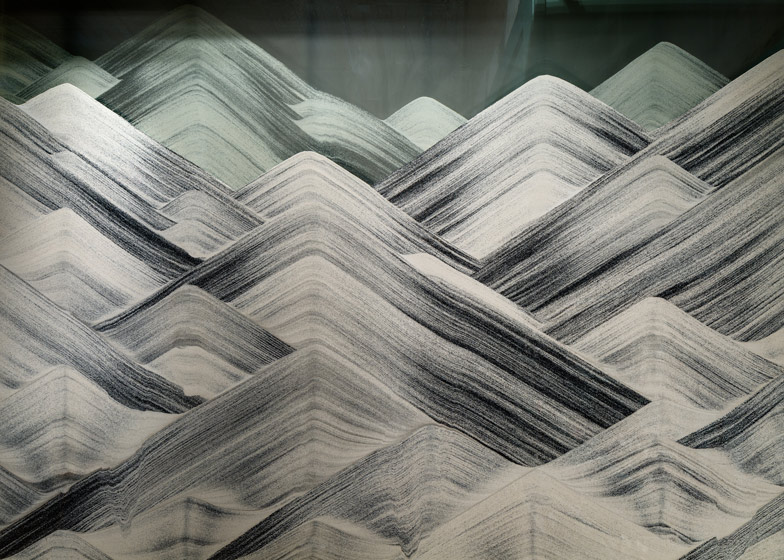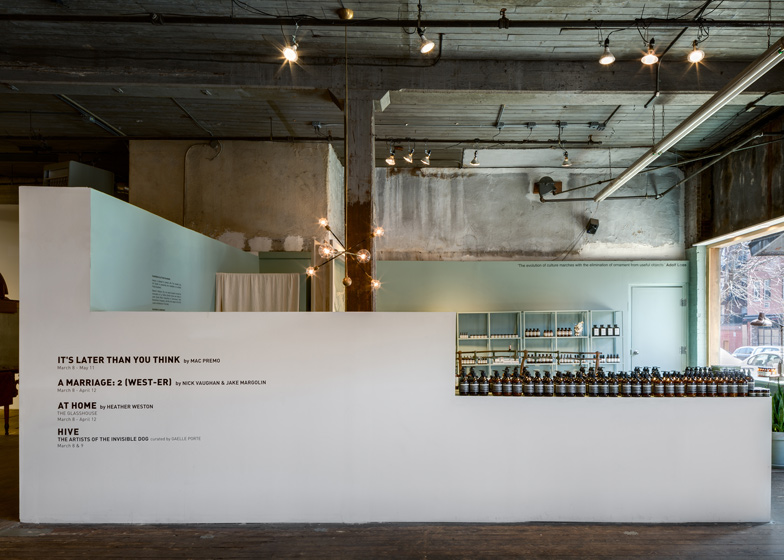Layers of sand that resemble a mountainous landscape will gradually move and change shape for the duration of this installation by Mexican architect Frida Escobedo for skincare brand Aesop's New York pop-up shop.
The installation at The Invisible Dog Art Center in Brooklyn was created by Escobedo to reflect its temporal setting and the idea of natural ornamentation espoused by Modernist architectural theorist Adolf Loos.
"Inspired by this principle, this installation for Aesop reflects the passing of time in the way of an inverse sedimentation," explained Escobedo in a statement displayed alongside the work.
A simple wooden structure, which also references the minimal aesthetic favoured by Modernist architects, supports and frames the glass panels containing black and white sand. The sand has been poured into gaps between the glass sheets, creating striated patterns that look like the peaks and valleys of a mountain range.
The sand will gradually sift through and out the bottom of the glass panel, causing the patterns to evolve over the five month period of the pop-up shop's residency.
"Installed in springtime in New York, it also recalls melting snow, Les Eaux de Mars, a change of season, optimism and expectation," Escobedo explained.
Aesops's products surround the space containing the artwork, which also features a freestanding vintage sink that echoes the raw, industrial backdrop of the gallery space.
Aesop is renowned for its unique shops created by leading architects and designers, including one in Kyoto with light fitting taken from squid fishing boats and another in New York with a ceiling covered in copies of The Paris Review.
Photography is by Rafael Gamo.
Here's some more information from Aesop:
Aesop pop-up at The Invisible Dog
Aesop is honoured to partner with The Invisible Dog Art Center in Brooklyn to present a temporary installation designed by architect Frida Escobedo. Launched on March 13, the innovative retail space will operate until the end of July.
While its main business is skin, hair and body care, Aesop has long nurtured a passionate interest in all forms of creative expression, and is well known for collaborations with individual practitioners and organizations alike. The endeavor sees the brand join with a New York exemplar of community-focused cultural engagement and one of the foremost proponents of Latin American Modernism.
The installation's centerpiece is a timber-framed glass enclosure containing meticulously segmented layers of sand that will shift over the next five months. Escobedo speaks of this feature having dual interpretations. In a materiality and form, it reference Modernism's shift away from ornamentation. And in keeping with one of Escoebdo's central concerns, it reflects temporality of its setting. The design is also influenced by Aesop's distinctive aesthetic, which the architect sees as aligned with the Japanese principle of shibusa or 'sophisticated austerity'.
Aesop selected the location because of its deep ties with the neighborhood and by the creative space and support network it provides for artists. The Invisible Dog manages to combine residency studios for artists, venues for exhibits and performances, and community engagement. Established in 2009 and nestled between Cobble Hill, Carroll Gardens and Boreum Hill, this interdisciplinary space is an exemplar of self-sustained, community-focused cultural engagement; and an acclaimed hub for experimentation and collaboration among artists.
Aesop was founded in Melbourne in 1987 and today offers its superlative formulations in signature stores and counters around the world and online. As the company evolves, meticulously considered design remains paramount to the creative of each space.



